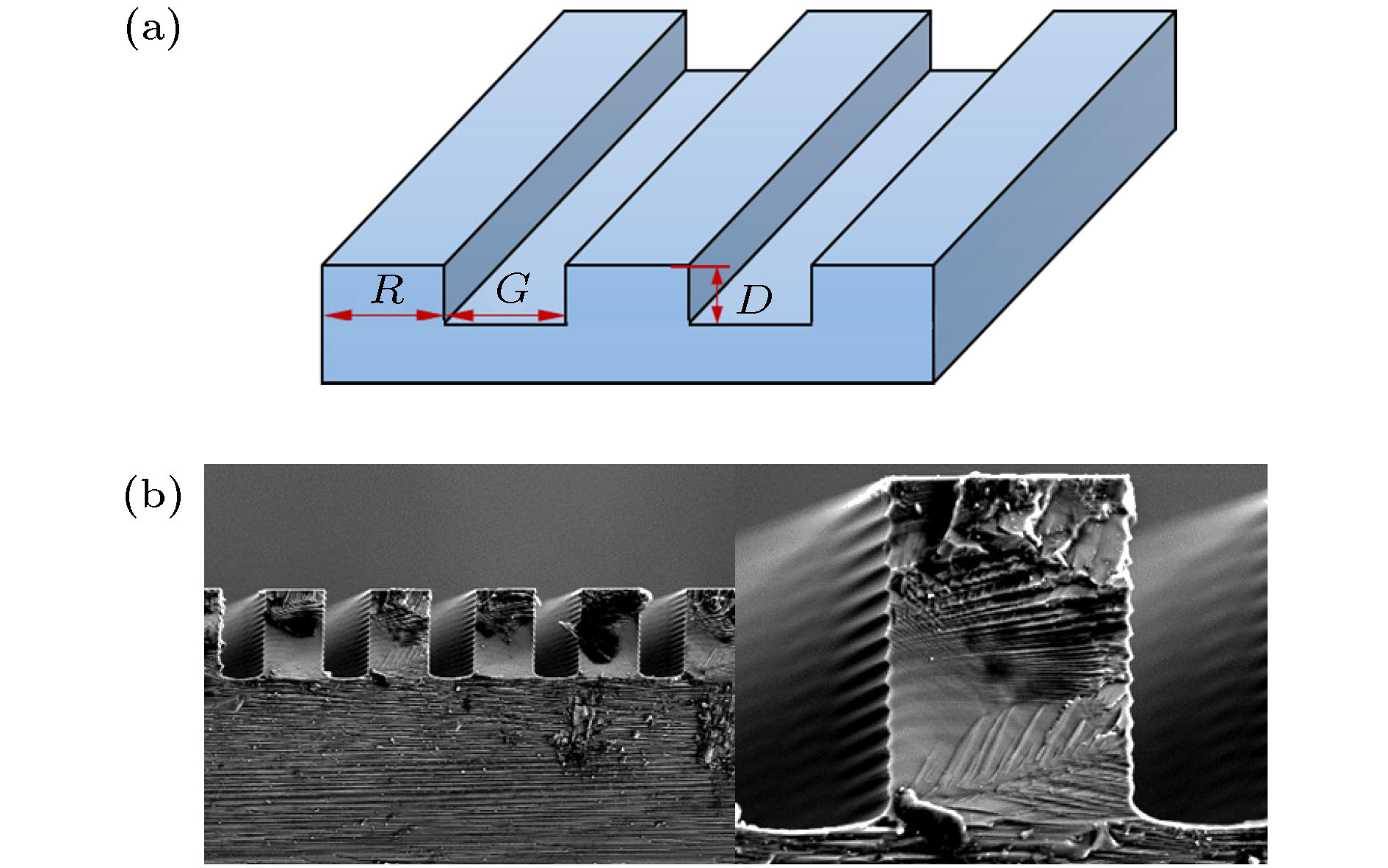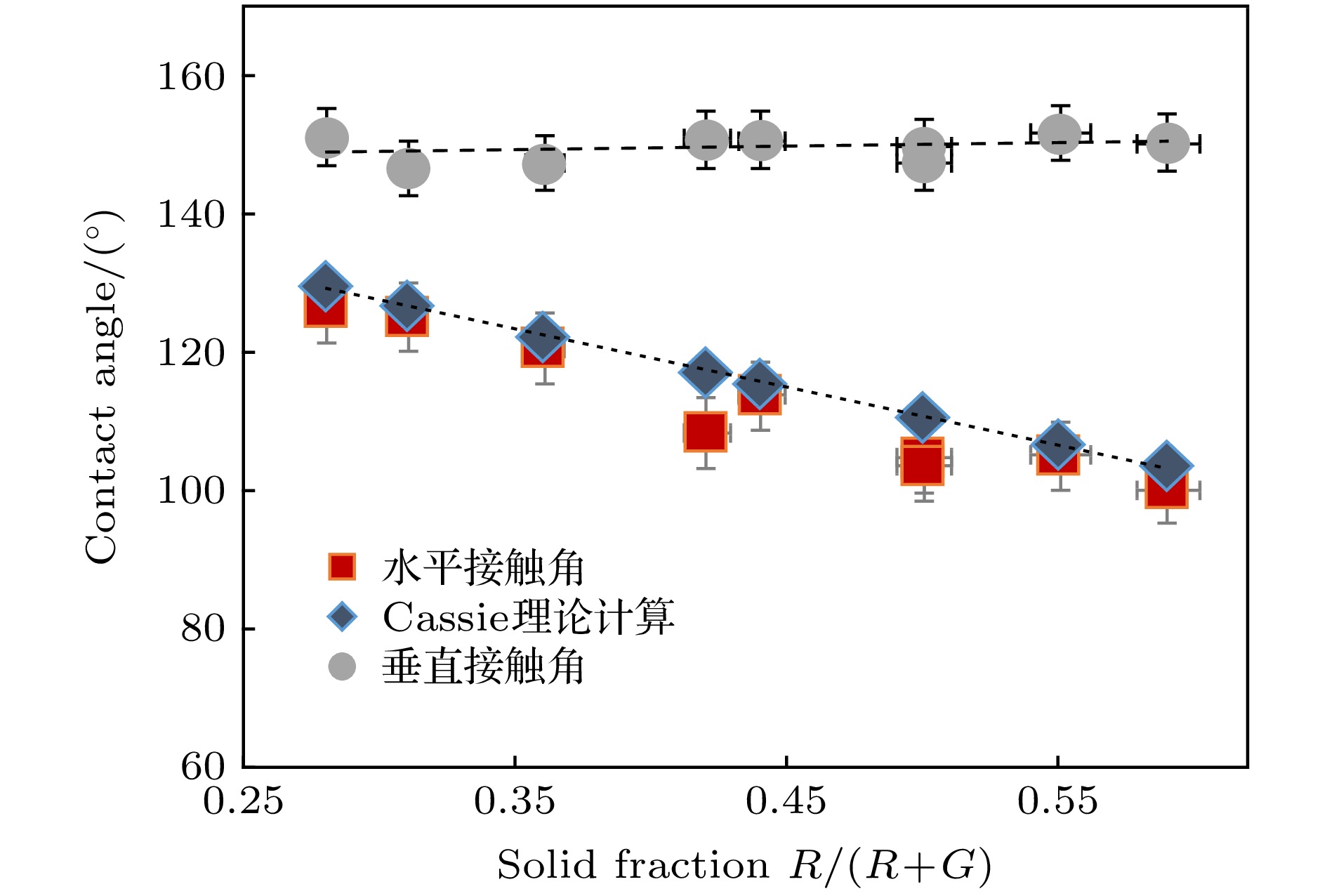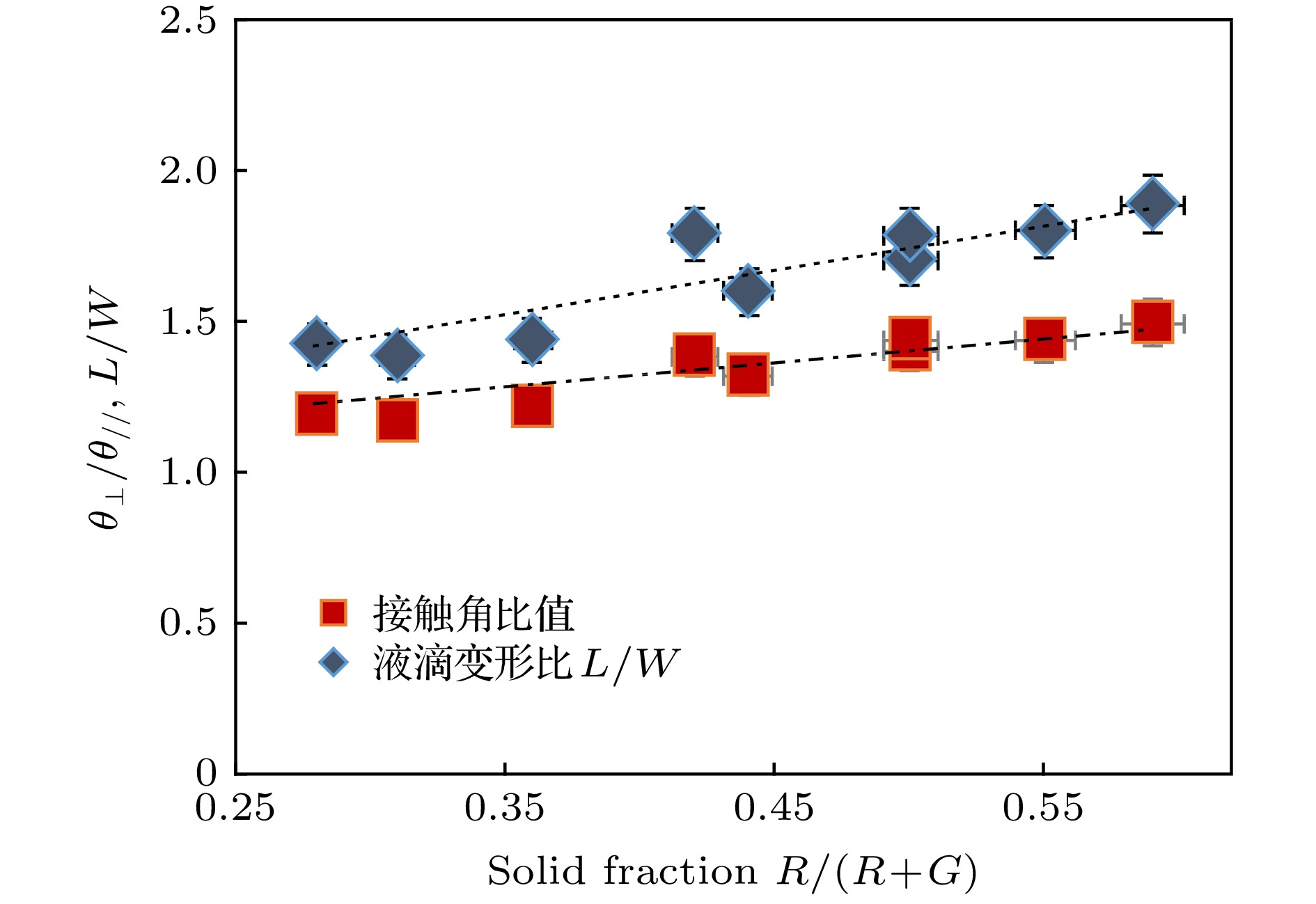-
Biomimetic microstructure has been used widely in the fields of microfluidics, micro-mixers, flow drag reduction, tribology, etc. When solid surface is modified with microstructure, it will inevitably influence the solid-liquid interfacial behaviors, such as adhesion, surface wetting, shear viscous resistance, and interfacial slip. Surface anisotropic wetting can be achieved by using either of anisotropic surface microstructure and chemically heterogeneous patterned surface, or both of them. And anisotropic wetting properties can be used to control the micro-flowing behaviors, like mixing, flowing direction and speed. The effect of microstructure on the surface wetting behavior is closely related to the size, shape and arrangement of microstructure. In the paper, the influence of micro-groove size on liquid anisotropic wetting behavior is studied. The results indicate that the droplet wetting state of the patterned surface used is Cassie state. According to the experimental results, we can see that the liquid flows easily along the groove direction with small motion resistance, thus resulting in a small contact angle. While the water droplet has a higher flowing resistance in the direction perpendicular to the groove direction due to the energy barrier caused by micro-groove, thus showing a larger contact angle. Meanwhile, the water droplet shows pinning and jump behavior during the spreading in the direction perpendicular to the micro-groove direction. The contact angle along the micro-groove direction θ// increases with groove width G increasing, and decreases with ridge width R increasing, which means that the parallel direction contact angle θ// is inversely proportional to the solid fraction R/(R + G). And the experimental contact angle θ// shows good consistence with that obtained from theoretical Cassie model. While the contact angle of water droplet perpendicular to groove direction θ⊥ almost keeps no change with groove width G nor ridge width R. Both the droplet deformation ratio L/W and contact angle ratio of the two featured direction θ⊥/θ// are proportional to the solid fraction R/(R + G). The water droplet shows anisotropic wetting behaviors, which means that the liquid motion resistances are different in these directions. The high droplet deformation ratio L/W and the high contact angle ratio θ⊥/θ// correspond to the large difference in motion resistance. And surface wetting behavior has a great influence on the micro-flowing behavior. Thus, the micro-flowing behavior can be regulated by changing the microgroove size. The present research can conduce to the understanding the wetting mechanism and flowing behaviors of liquid droplet on patterned surface.
-
Keywords:
- micro-groove /
- anisotropic wetting /
- contact angle /
- pinning effect
[1] Jokerst J C, Emory J M, Henry C S 2012 Analyst 137 24
 Google Scholar
Google Scholar
[2] Ballerini D R, Li X, Shen W 2012 Microfluid Nanofluid 13 769
 Google Scholar
Google Scholar
[3] Sharma R, Ragavan K V, Thakur M S, Raghavarao K S M S 2015 Biosens. Bioelectron. 74 612
 Google Scholar
Google Scholar
[4] 蒋成刚 2014 博士学位论文 (大连: 大连理工大学)
Jiang C G 2014 Ph. D. Dissertation (Dalian: Dalian University of Technology) (in Chinese)
[5] 张慧 2014 硕士学位论文 (苏州: 苏州大学)
Zhang H 2015 M. S. Thesis (Suzhou: Soochow University) (in Chinese)
[6] 王铁强 2013 博士学位论文 (长春: 吉林大学)
Wang T Q 2013 Ph. D. Dissertation (Changchun: Jilin university) (in Chinese)
[7] 蔡东海, 汪前彬, 赵天艺, 刘欢, 江雷 2014 化学通报 77 743
Cai D H, Wang Q B, Zhao T Y, Liu H, Jiang L 2014 Chemistry 77 743
[8] 乔小溪, 张向军, 田煜, 孟永钢 2017 物理学报 66 044703
 Google Scholar
Google Scholar
Qiao X X, Zhang X J, Tian Y, Meng Y G 2017 Acta. Phys. Sin. 66 044703
 Google Scholar
Google Scholar
[9] 王鹏伟, 刘明杰, 江雷 2016 物理学报 65 186801
 Google Scholar
Google Scholar
Wang P W, Liu M J, Jiang L 2016 Acta. Phys. Sin. 65 186801
 Google Scholar
Google Scholar
[10] Yang F C, Chen X P 2019 Chin. Phys. B 28 044701
 Google Scholar
Google Scholar
[11] Liu S S, Zhang C H, Zhang H B, Zhou J, He J G, Yin H Y 2013 Chin. Phys. B 22 106801
 Google Scholar
Google Scholar
[12] Chung J Y, Youngblood J P, Stafford C M 2007 Soft Matter 3 1163
 Google Scholar
Google Scholar
[13] Priezjev N V 2011 J. chem. Phys. 135 204704
 Google Scholar
Google Scholar
[14] Kim T I, Suh K Y 2009 Soft Matter 5 4131
 Google Scholar
Google Scholar
[15] Kim G H, Lee B H, Im H, Jeon S B, Kim D, Seol M L, Hwang H, Choi Y K 2016 RSC Adv. 6 41914
 Google Scholar
Google Scholar
[16] Chu K H, Xiao R, Wang E N 2010 Nat. Mater. 9 413
 Google Scholar
Google Scholar
[17] Wang S L, Yu N Z, Wang T Q, Ge P, Ye S S, Xue P H, Liu W D, Shen H Z, Zhang J H, Yang B 2016 ACS Appl. Mater. Interfaces 8 13094
 Google Scholar
Google Scholar
[18] Zhao Y, Lu Q H, Li M, Li X 2007 Langmuir 23 6212
 Google Scholar
Google Scholar
[19] Xia D Y, Brueck S R J 2008 Nano Lett. 8 2819
 Google Scholar
Google Scholar
[20] Yildirim A, Yunusa M, Ozturk F E, Kanik M, Bayindir M 2014 Adv. Funct. Mater. 24 4569
 Google Scholar
Google Scholar
-
表 1 微矩形凹槽的尺寸参数
Table 1. Parameters of micro-rectangular grooves used in the experiments.
序号 G/μm R/μm D/μm Solid fraction
R/(R + G)1 5 5 19 0.50 2 7 5 19 0.42 3 9 5 19 0.36 4 11 5 19 0.31 5 13 5 19 0.28 6 9 7 19 0.44 7 9 9 19 0.50 8 9 11 19 0.55 9 9 13 19 0.59 -
[1] Jokerst J C, Emory J M, Henry C S 2012 Analyst 137 24
 Google Scholar
Google Scholar
[2] Ballerini D R, Li X, Shen W 2012 Microfluid Nanofluid 13 769
 Google Scholar
Google Scholar
[3] Sharma R, Ragavan K V, Thakur M S, Raghavarao K S M S 2015 Biosens. Bioelectron. 74 612
 Google Scholar
Google Scholar
[4] 蒋成刚 2014 博士学位论文 (大连: 大连理工大学)
Jiang C G 2014 Ph. D. Dissertation (Dalian: Dalian University of Technology) (in Chinese)
[5] 张慧 2014 硕士学位论文 (苏州: 苏州大学)
Zhang H 2015 M. S. Thesis (Suzhou: Soochow University) (in Chinese)
[6] 王铁强 2013 博士学位论文 (长春: 吉林大学)
Wang T Q 2013 Ph. D. Dissertation (Changchun: Jilin university) (in Chinese)
[7] 蔡东海, 汪前彬, 赵天艺, 刘欢, 江雷 2014 化学通报 77 743
Cai D H, Wang Q B, Zhao T Y, Liu H, Jiang L 2014 Chemistry 77 743
[8] 乔小溪, 张向军, 田煜, 孟永钢 2017 物理学报 66 044703
 Google Scholar
Google Scholar
Qiao X X, Zhang X J, Tian Y, Meng Y G 2017 Acta. Phys. Sin. 66 044703
 Google Scholar
Google Scholar
[9] 王鹏伟, 刘明杰, 江雷 2016 物理学报 65 186801
 Google Scholar
Google Scholar
Wang P W, Liu M J, Jiang L 2016 Acta. Phys. Sin. 65 186801
 Google Scholar
Google Scholar
[10] Yang F C, Chen X P 2019 Chin. Phys. B 28 044701
 Google Scholar
Google Scholar
[11] Liu S S, Zhang C H, Zhang H B, Zhou J, He J G, Yin H Y 2013 Chin. Phys. B 22 106801
 Google Scholar
Google Scholar
[12] Chung J Y, Youngblood J P, Stafford C M 2007 Soft Matter 3 1163
 Google Scholar
Google Scholar
[13] Priezjev N V 2011 J. chem. Phys. 135 204704
 Google Scholar
Google Scholar
[14] Kim T I, Suh K Y 2009 Soft Matter 5 4131
 Google Scholar
Google Scholar
[15] Kim G H, Lee B H, Im H, Jeon S B, Kim D, Seol M L, Hwang H, Choi Y K 2016 RSC Adv. 6 41914
 Google Scholar
Google Scholar
[16] Chu K H, Xiao R, Wang E N 2010 Nat. Mater. 9 413
 Google Scholar
Google Scholar
[17] Wang S L, Yu N Z, Wang T Q, Ge P, Ye S S, Xue P H, Liu W D, Shen H Z, Zhang J H, Yang B 2016 ACS Appl. Mater. Interfaces 8 13094
 Google Scholar
Google Scholar
[18] Zhao Y, Lu Q H, Li M, Li X 2007 Langmuir 23 6212
 Google Scholar
Google Scholar
[19] Xia D Y, Brueck S R J 2008 Nano Lett. 8 2819
 Google Scholar
Google Scholar
[20] Yildirim A, Yunusa M, Ozturk F E, Kanik M, Bayindir M 2014 Adv. Funct. Mater. 24 4569
 Google Scholar
Google Scholar
Catalog
Metrics
- Abstract views: 17989
- PDF Downloads: 345
- Cited By: 0















 DownLoad:
DownLoad:







